Microsoft 70-761 Exam Practice Questions (P. 2)
- Full Access (201 questions)
- One Year of Premium Access
- Access to one million comments
- Seamless ChatGPT Integration
- Ability to download PDF files
- Anki Flashcard files for revision
- No Captcha & No AdSense
- Advanced Exam Configuration
Question #6
Note: This question is part of a series of questions that present the same scenario. Each question in the series contains a unique solution that might meet the stated goals. Some question sets might have more than one correct solution, while others might not have a correct solution.
After you answer a question in this section. You will NOT be able to return to it. As a result, these questions will not appear in the review screen.
You create a table named Customer by running the following Transact-SQL statement:
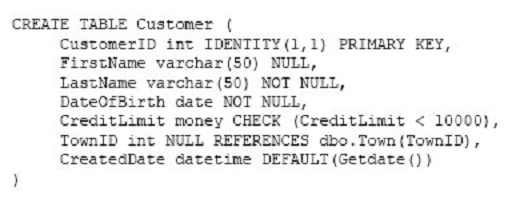
You must insert the following data into the Customer table:

You need to ensure that both records are inserted or neither record is inserted.
Solution: You run the following Transact-SQL statement:

Does the solution meet the goal?
After you answer a question in this section. You will NOT be able to return to it. As a result, these questions will not appear in the review screen.
You create a table named Customer by running the following Transact-SQL statement:

You must insert the following data into the Customer table:

You need to ensure that both records are inserted or neither record is inserted.
Solution: You run the following Transact-SQL statement:

Does the solution meet the goal?
- AYes
- BNo
Correct Answer:
A
With the INSERT INTO..VALUES statement we can insert both values with just one statement. This ensures that both records or neither is inserted.
References:
https://msdn.microsoft.com/en-us/library/ms174335.aspx
A
With the INSERT INTO..VALUES statement we can insert both values with just one statement. This ensures that both records or neither is inserted.
References:
https://msdn.microsoft.com/en-us/library/ms174335.aspx
send
light_mode
delete
Question #7
Note: This question is part of a series of questions that present the same scenario. Each question in the series contains a unique solution that might meet the stated goals. Some question sets might have more than one correct solution, while others might not have a correct solution.
After you answer a question in this section. You will NOT be able to return to it. As a result, these questions will not appear in the review screen.
You have a database that tracks orders and deliveries for customers in North America. The database contains the following tables:
Sales.Customers -
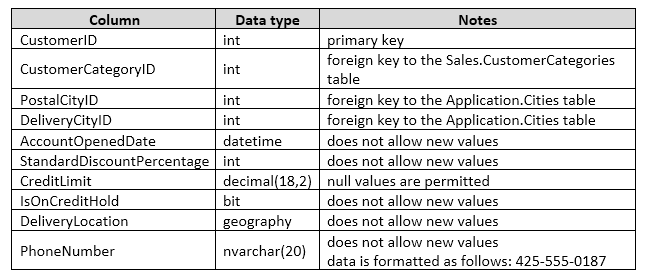
Application.Cities -

Sales.CustomerCategories -

The company's development team is designing a customer directory application. The application must list customers by the area code of their phone number. The area code is defined as the first three characters of the phone number.
The main page of the application will be based on an indexed view that contains the area and phone number for all customers.
You need to return the area code from the PhoneNumber field.
Solution: You run the following Transact-SQL statement:

Does the solution meet the goal?
After you answer a question in this section. You will NOT be able to return to it. As a result, these questions will not appear in the review screen.
You have a database that tracks orders and deliveries for customers in North America. The database contains the following tables:
Sales.Customers -

Application.Cities -

Sales.CustomerCategories -

The company's development team is designing a customer directory application. The application must list customers by the area code of their phone number. The area code is defined as the first three characters of the phone number.
The main page of the application will be based on an indexed view that contains the area and phone number for all customers.
You need to return the area code from the PhoneNumber field.
Solution: You run the following Transact-SQL statement:

Does the solution meet the goal?
- AYes
- BNo
Correct Answer:
B
The function should return nvarchar(10) and not a TABLE.
References:
https://sqlstudies.com/2014/08/06/schemabinding-what-why/
B
The function should return nvarchar(10) and not a TABLE.
References:
https://sqlstudies.com/2014/08/06/schemabinding-what-why/
send
light_mode
delete
Question #8
Note: This question is part of a series of questions that present the same scenario. Each question in the series contains a unique solution that might meet the stated goals. Some question sets might have more than one correct solution, while others might not have a correct solution.
After you answer a question in this section. You will NOT be able to return to it. As a result, these questions will not appear in the review screen.
You have a database that tracks orders and deliveries for customers in North America. The database contains the following tables:
Sales.Customers -
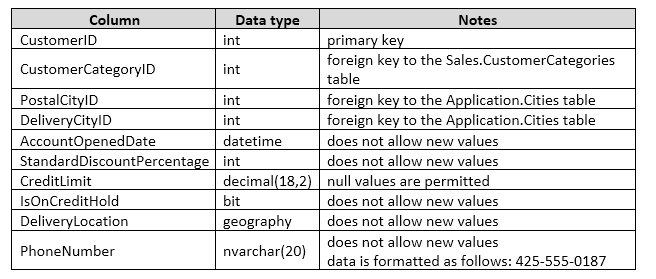
Application.Cities -

Sales.CustomerCategories -

The company's development team is designing a customer directory application. The application must list customers by the area code of their phone number. The area code is defined as the first three characters of the phone number.
The main page of the application will be based on an indexed view that contains the area and phone number for all customers.
You need to return the area code from the PhoneNumber field.
Solution: You run the following Transact-SQL statement:

Does the solution meet the goal?
After you answer a question in this section. You will NOT be able to return to it. As a result, these questions will not appear in the review screen.
You have a database that tracks orders and deliveries for customers in North America. The database contains the following tables:
Sales.Customers -

Application.Cities -

Sales.CustomerCategories -

The company's development team is designing a customer directory application. The application must list customers by the area code of their phone number. The area code is defined as the first three characters of the phone number.
The main page of the application will be based on an indexed view that contains the area and phone number for all customers.
You need to return the area code from the PhoneNumber field.
Solution: You run the following Transact-SQL statement:

Does the solution meet the goal?
- AYes
- BNo
Correct Answer:
B
As the result of the function will be used in an indexed view we should use schemabinding.
References:
https://sqlstudies.com/2014/08/06/schemabinding-what-why/
B
As the result of the function will be used in an indexed view we should use schemabinding.
References:
https://sqlstudies.com/2014/08/06/schemabinding-what-why/
send
light_mode
delete
Question #9
Note: This question is part of a series of questions that present the same scenario. Each question in the series contains a unique solution that might meet the stated goals. Some question sets might have more than one correct solution, while others might not have a correct solution.
After you answer a question in this section. You will NOT be able to return to it. As a result, these questions will not appear in the review screen.
You have a database that tracks orders and deliveries for customers in North America. The database contains the following tables:
Sales.Customers -
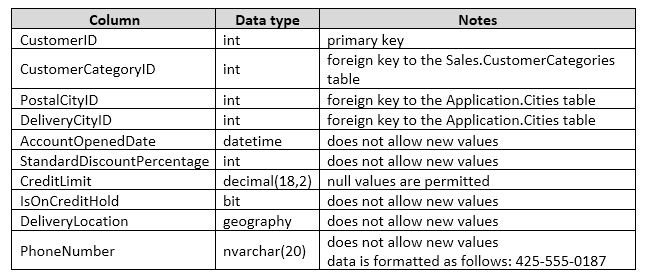
Application.Cities -

Sales.CustomerCategories -

The company's development team is designing a customer directory application. The application must list customers by the area code of their phone number. The area code is defined as the first three characters of the phone number.
The main page of the application will be based on an indexed view that contains the area and phone number for all customers.
You need to return the area code from the PhoneNumber field.
Solution: You run the following Transact-SQL statement:
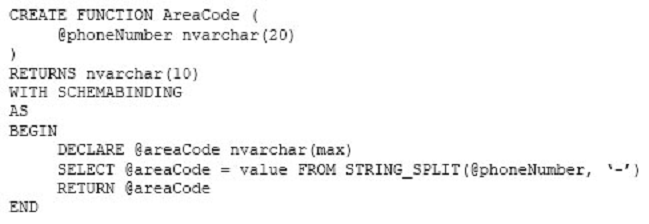
Does the solution meet the goal?
After you answer a question in this section. You will NOT be able to return to it. As a result, these questions will not appear in the review screen.
You have a database that tracks orders and deliveries for customers in North America. The database contains the following tables:
Sales.Customers -

Application.Cities -

Sales.CustomerCategories -

The company's development team is designing a customer directory application. The application must list customers by the area code of their phone number. The area code is defined as the first three characters of the phone number.
The main page of the application will be based on an indexed view that contains the area and phone number for all customers.
You need to return the area code from the PhoneNumber field.
Solution: You run the following Transact-SQL statement:

Does the solution meet the goal?
- AYes
- BNo
Correct Answer:
B
We need SELECT TOP 1 @areacode =.. to ensure that only one value is returned.
B
We need SELECT TOP 1 @areacode =.. to ensure that only one value is returned.
send
light_mode
delete
Question #10
Note: This question is part of a series of questions that use the same scenario. For your convenience, the scenario is repeated in each question. Each question presents a different goal and answer choices, but the text of the scenario is exactly the same in each question in this series.
You query a database that includes two tables: Project and Task. The Project table includes the following columns:

The Task table includes the following columns:

You plan to run the following query to update tasks that are not yet started:
UPDATE Task SET StartTime = GETDATE() WHERE StartTime IS NULL
You need to return the total count of tasks that are impacted by this UPDATE operation, but are not associated with a project.
What set of Transact-SQL statements should you run?

A.

B.

C.

D.
You query a database that includes two tables: Project and Task. The Project table includes the following columns:

The Task table includes the following columns:

You plan to run the following query to update tasks that are not yet started:
UPDATE Task SET StartTime = GETDATE() WHERE StartTime IS NULL
You need to return the total count of tasks that are impacted by this UPDATE operation, but are not associated with a project.
What set of Transact-SQL statements should you run?

A.

B.

C.

D.
Correct Answer:
B
The WHERE clause of the third line should be WHERE ProjectID IS NULL, as we want to count the tasks that are not associated with a project.
B
The WHERE clause of the third line should be WHERE ProjectID IS NULL, as we want to count the tasks that are not associated with a project.
send
light_mode
delete
All Pages
